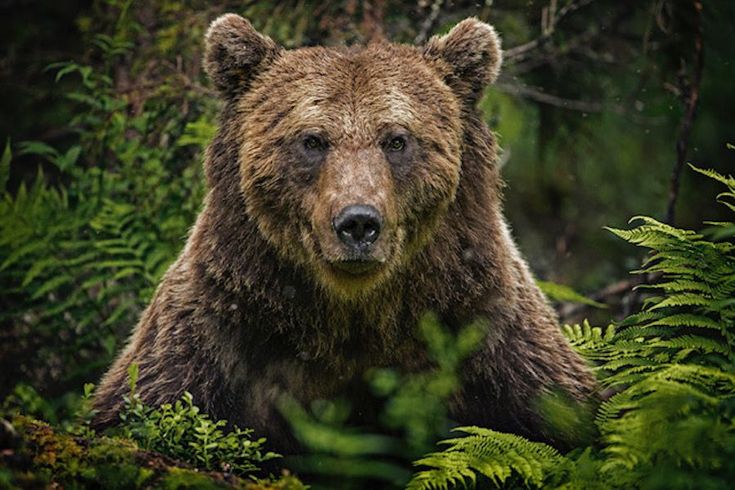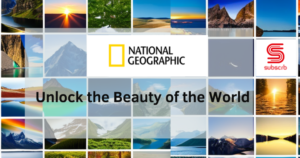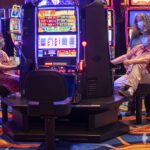

National Geographic Photographers Create ‘Love Letter to Nature’
Uri Løvevild Golman and Helle Løvevild Golman are National Geographic Explorers and conservation photographers who just completed a project and book they call their love letter to nature. “Project WILD” features images and videos from their 25 expeditions on all seven continents over five years.
Helle spent much of her childhood sailing with her family around Denmark. She went on to travel all seven continents as a wildlife guide, leading safaris in Africa and working as an expedition leader in the Arctic and Antarctica.
After growing up in the Danish countryside, Uri became a graphic designer and photographer. He’s published several books featuring his photography from the Arctic, Africa, and India and has won various awards including Wildlife Photographer of the Year, People’s Choice and Conservation Photographer of the Year.
The pair met and fell in love during an expedition in the Arctic. They now live in a small cabin in the woods in Zealand, Denmark, working on nature conservation projects through their foundation.
Helle and Uri talked to Treehugger via email about their work and Project WILD. (Their responses have been edited.)
Helle and Uri: An expedition always starts with a dream of becoming a visitor to a wild animal’s home, nature. There are thousands of hours of preparation. We always speculate like crazy about how close we can get, and whether we should build a hide for us to become invisible in or wear camouflage ghillie suits. Will the rangers and scientists, with whom we work so closely, like us? There are so many unknown factors, so many situations that can arise and go either way. But one thing we know is that when we are there, we follow the rhythm of nature and wildlife; we follow our instincts and work with what we have.
We never carry too much camera equipment; we make up our minds according to the situation. Otherwise, we would get too tired of carrying heavy gear around in the jungle or the tundra. Here, simplicity rules: One camera and one lens, water, insect repellent, some food and a lot of stamina, that’s it! Then we can walk for 12 hours a day in the forest and continue to do so for a whole month.
We love what we do, and we would not swap it for any other job on this planet. We are always together out there; we share our passion for the wild. For us, being together is very essential; we always have each other to lean against on the tough days and, most importantly, to share the many breathtaking moments of living and working in the wild, getting really close to wild animals.
Treehugger: I know it’s hard to sum up so many years and so many expeditions, but where have you gone and what have you done?
One thing we must tell you is that the magic always happens on the last day of the expedition — the guys filming for the BBC and the National Geographic wildlife documentaries all say it and all the others as well!
We have been to the farthest corners of our beautiful planet, always travelling with great respect and gratitude for what we have seen and discovered: from the Ross Sea in Antarctica to the equatorial forests and savannahs of Africa; from the world’s largest wetland area, the Pantanal in South America, to the North American archipelago with its tempered rainforest; from the world’s largest national park in Northeast Greenland, sailing with the Danish Navy vessel I/F Knud Rasmussen, to the mighty taiga, the boreal forest of Finland; and from Borneo’s lowland jungle to the cloud forest of Papua New Guinea.
Along the way, we have made feature articles for National Geographic and other magazines as well as television documentaries about our life in the wild, and we have anchored a spot in The Guinness Book of World Records.
We have photographed everything from the world’s largest penguin and the rarest seal to the great apes — chimps, gorillas and orangutans — the powerful jaguar and the funny-looking anteater, the exceptional coastal wolf and white spirit bears, the iconic polar bear, mighty brown bears and extravagant birds of paradise.
When we are out in the wild surrounded by nature and animals, we feel at home. We feel a love and a primeval force of energy there. We need to reconnect our hearts with our minds and find the love of the wild that we are all born with — then we can save the last wild places, and with that, humanity.
What is the goal of “Project WILD”?
We sat there in our small apartment, head over heels in love, and we wanted to make a difference for nature and start a project larger than us.
With all the love between us, there was no doubt that we had to make our life project together, and that is why we started Project WILD with 25 expeditions on all seven continents over five years. We wanted to photo document the world’s last wild places and endangered animals. With our mantra in mind: What You Love – You Will Protect, we embarked on a voyage and we had no clue where it would lead us, except that this would be our life’s masterpiece!
Many photographers before us have made huge projects, produced amazing images and made beautiful photographic books — how would our Project WILD be different and make a difference?
What do you hope to capture with your photos?
We believe that animals have emotions like us, and it has been proven, e.g. that ravens can feel love and dogs show empathy, the same with chimpanzees and elephants — we are all the same. With our images we want to express the intimacy and emotional closeness in an animal. No more gory images of dead elephants and dehorned rhinos, those images have their place in other contexts.
We believe that we are all born with a love of the wild — like all kids love animals — we need to reconnect your heart with our mind, a find that love we are all born with. Because, as our mantra expresses; What You Love – You Will Protect. And with love we can save the planet.
What were some of your favorite expeditions?
Working for the National Geographic Society on a grant, we became National Geographic Explorers. Our task was to document the elusive mandrill in Gabon in Central West Africa, a species whose behavior had not yet been photographically documented. This expedition would truly see us both going the extra mile. We were collaborating with the senior scientist on the mandrill and staying at the field station run by Dr David Lehman, a strong, tough and handsome guy who looked like something out of a Levi’s commercial. He was a real “badass scientist” with a huge heart, and he quickly became a very dear friend of ours.
Shortly after arriving in the capital Libreville, we travelled to the beautifully located field station overlooking grassland, rivers and gallery forests, and then straight from there out in the jungle and into cone-shaped polyester hides, lying flat on the ground, which David covered meticulously with camouflage netting, branches and soil. And there we stayed for the next 11 hours; only Uri had a radio to communicate with David. That was tough!
This is how our friendship began, and the 11 hours were just the beginning of many more hours, days and weeks spent in small and narrow hides, between roots and among centipedes and other colorful insects, lying in impossible and uncomfortable positions. A true test of endurance, mentally as well as physically. When not in the small, humid hides, we walked with David and his rangers for 12 hours a day wearing military camouflage ghillie suits — Uri looking exactly like a green version of Chewbacca from “Star Wars.”
Walking like this, we involuntarily became entangled in minute fire ants’ homes, and the burning sensation from their bites became familiar after having hundreds of them bite us. We could go on about the hundreds of ticks that Uri unwillingly provided a new home for and the sweat bees crawling into every nook and cranny of our bodies. This is the other side of the glamorous life of being a wildlife photographer, but it is all worth it!
And one more story we just have to tell you: The experience of how a forest elephant almost ate all of our money, although it was safely tucked away in the pocket of Uri’s pants which had been left to dry on the line outside our shed. But luckily for us, it was kind enough to eat only a small portion of Uri’s pants, leaving the rest completely chewed up in a pool of elephant saliva. The next day the same elephant, clearly not a fan of human male testosterone, penetrated the bumper and front windscreen of our land cruiser with its strong tusks, tore off the wing mirrors, crashed both side windows, stole and emptied David’s backpack, ate his cap, swung around with his expensive binoculars and trunk-slapped the rear window.
Treehugger note: Uri and Helle also told stories about a trip to Greenland to photograph narwhals and polar bears. They were convinced they heard a polar bear roaring but it was only Uri snoring. “That night, we fell asleep to the sound of narwhals blowing out air and the arctic fox yelping,” they said.
On another trip, they were on the outer rim of the archipelago of British Columbia in Western Canada in a sailboat in search of the elusive sea wolf. After seeing orcas, sea otters, bears, and whales, they finally spotted one, running toward them.
“The next two hours gave us the greatest wildlife experience we have ever had. Two hours with a wild sea wolf, unbelievable! It just came closer and closer, with no hesitation, seeming very curious,” they said. “We could have just stretched out our arms, and we would have felt the fur of our wild companion that showed no aggression at all. We felt the true call of the WILD. It was just there with us; it even put its snout into Uri’s 600mm lens and had a taste of his rubber boot. Several times we both cried with happiness and hoped for this moment to last forever.”
Was there ever a photo that you weren’t able to make?
We always go the extra mile and learn from people that have lived their whole life in nature.
What do you hope to do next?
Helle: Sitting there hour after hour, day after day in tiny photo hides, trying to be invisible and waiting for the sought after animals to come by, we had plenty of time to think about how we could make Project WILD last forever and turn it into something more ‘solid.’ We quickly figured out that we had to turn WILD, ourselves and our brand, into a nature conservation foundation.
We were lucky enough to have a television crew filming our life working in the wild. This would take WILD even further and for that we are incredibly grateful! For our 25th expedition, we went back to Gabon — we had been there twice photographing the very elusive mandrill with National Geographic, but this time we were looking for lowland gorillas and forest elephants, while filming our documentary series “Our Wild World.”
Here something unforeseen happened; a suspected poacher attacked us with a big knife. The full story of what happened is too comprehensive to be told here — but in short … with multiple stab wounds, Uri tackled the aggressor to the ground, I jumped into the fight, and we fought him off together. While we were fighting for our lives, our camera lady, Hannelore, did the only right thing to do: She got hold of our vehicle so we could drive off to the nearest hospital. Uri had several lengthy surgeries over the following days: heart, liver, arteries etc. My lion fought bravely for our lives — had Uri died there, so had I! Again, Uri made the impossible possible; you survived, and with valor you won! And you are now able to walk with support. I am so proud of you, my Warrior of Love and Nature!
At one point during your two and a half years of hospitalization and round-the-clock rehabilitation, you said something which shows exactly who you are and what you stand for: “Helle, now I know why it happened; now we have an even stronger voice for nature conservation!” You are the strongest of men I have ever met; full of willpower and with an outstanding positivity.
Our lives undoubtedly changed that day in the market in Gabon. But having a large project called WILD and a love for each other as big as the universe has also kept us going – even when it seemed impossible. The future looks bright and full of new adventures; we have climbed “a ladder” and reached a new level of how to make a difference for the wild. With WILD Nature Foundation, we have gathered our contacts, which we have made over many years of photographing in the field, and we can’t wait for all the inspiring work that lays ahead of us. At the moment of writing, we are working on establishing a national park in Western Greenland.





